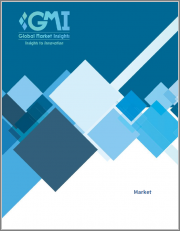
|
시장보고서
상품코드
1411269
이식형 제세동기(ICD) 시장 : 제품 유형별, 최종 용도별 & 예측(2024-2032년)Implantable Cardioverter Defibrillators Market - By Product (Transvenous ICDs, Subcutaneous ICDs), By Type (Single-Chamber, Dual-Chamber, Biventricular Devices), End-use (Hospitals, Ambulatory Surgical Centers) & Forecast, 2024-2032 |
||||||
심장 이식형 제세동기(ICD) 시장 규모는 2024년부터 2032년까지 6.4% 이상 성장할 것으로 예상됩니다.
심혈관 질환, 특히 부정맥과 갑작스런 심장마비의 유병률 증가로 인해 이식형 제세동기(ICD)에 대한 수요가 증가하고 있습니다. 인구 고령화와 생활습관 관련 위험 요인 증가로 인해 ICD 기술의 발전이 가속화되고 있습니다. 예를 들어, 2023년 12월에는 PROFID EHRA 시험이 시작되어 심부전을 동반한 심장마비 생존자에게 제세동기를 이식하는 표준 방법을 재평가하는 첫 번째 임상시험이 시작되었습니다.
예방적 건강 관리 대책에 대한 인식이 높아지고 유리한 상환 정책이 유입되면서 이식형 제세동기의 채택을 촉진할 것으로 보입니다. 원격 모니터링 및 무연 장치의 통합을 포함한 지속적인 연구 개발 활동은 제품의 효과와 접근성을 더욱 향상시키고 있습니다. 또한, 의료 서비스 제공업체와 기기 제조업체 간의 전략적 제휴와 혁신적인 심장 솔루션에 대한 규제 당국의 지원 증가는 업계 확장을 보완할 것입니다.
이식형 제세동기 시장은 제품, 유형, 최종 용도 및 지역으로 분류됩니다.
제품 유형별로는 피하 이식형 제세동기 분야 시장 점유율이 2024년부터 2032년까지 6.9%의 연평균 복합 성장률(CAGR)을 나타낼 것으로 예상됩니다. 이러한 성장은 저침습성으로 인해 피하 이식형 제세동기(S-ICD)에 대한 선호도가 높아졌기 때문입니다. 감염 위험 감소, 환자 편의성 향상, S-ICD 기술의 발전으로 인해 생명을 위협하는 부정맥 관리에 대한 제품 채택이 증가할 것으로 예상됩니다.
심장 이식형 제세동기 산업은 고급 부정맥 관리에 대한 수요 증가로 인해 듀얼 챔버 ICD 유형 부문에서 2024년부터 2032년까지 연평균 복합 성장률(CAGR)7%로 확대될 것으로 추정됩니다. 듀얼 챔버 ICD의 향상된 감지 기능, 향상된 감지 정확도, 최적화된 치료 제공은 다양한 심장 질환을 가진 환자의 복잡한 요구에 대응하는 데 도움이 될 수 있습니다.
지역별로 보면 유럽의 이식형 제세동기 산업은 2024년부터 2032년까지 연평균 복합 성장률(CAGR)6.1%를 나타낼 것으로 예상됩니다. 이러한 성장의 배경에는 인구 고령화, 심혈관 질환 발생률 증가, 심장 장비의 기술 발전이 있습니다. 또한, 의료 정책의 도입, 예방 심장학에 대한 인식 증가, 의료 기관과 장치 제조업체 간의 전략적 제휴가 이 지역 전체 산업의 성장을 가속할 것으로 보입니다.
목차
제1장 조사 방법과 조사 범위
제2장 주요 요약
제3장 이식형 제세동기 산업 인사이트
- 업계 생태계 분석
- 업계에 대한 영향요인
- 성장 촉진요인
- 업계의 잠재적 리스크&과제
- 성장 가능성 분석
- 제품별
- 유형별
- 최종 용도별
- 규제 상황
- 미국
- 유럽
- 상환 시나리오
- 향후 시장 동향
- 기술적 전망
- 가격 분석
- 업계 상황
- Porter's Five Forces 분석
- PESTEL 분석
제4장 경쟁 구도
- 서론
- 기업 매트릭스 분석
- 기업별 시장 점유율 분석
- 주요 시장 기업 - 경쟁 분석
- 경쟁 포지셔닝 매트릭스
- 전략 대시보드
제5장 이식형 제세동기 시장 규모와 예측 : 제품별, 2018년-2032년
- 주요 동향 : 제품별
- 경정맥 이식형 제세동기
- 피하 이식형 제세동기
제6장 이식형 제세동기 시장 규모와 예측 : 유형별, 2018년-2032년
- 주요 동향 : 유형별
- 싱글 챔버 ICD
- 듀얼 챔버 ICD
- 양심실 디바이스
제7장 이식형 제세동기 시장 규모와 예측 : 최종 용도별, 2018-2032년
- 주요 동향 : 최종 용도별
- 병원
- 외래수술센터(ASC)
- 기타 최종사용자
제8장 이식형 제세동기 시장 규모와 예측 : 지역별, 2018-2032년
- 주요 동향 : 지역별
- 북미
- 미국
- 캐나다
- 유럽
- 독일
- 영국
- 프랑스
- 스페인
- 이탈리아
- 기타 유럽
- 아시아태평양
- 중국
- 일본
- 인도
- 호주
- 한국
- 기타 아시아태평양
- 라틴아메리카
- 브라질
- 멕시코
- 아르헨티나
- 기타 라틴아메리카
- 중동 및 아프리카
- 남아프리카공화국
- 사우디아라비아
- 아랍에미리트(UAE)
- 기타 중동 및 아프리카
제9장 기업 개요
- Abbott Laboratories
- Medtronic plc
- BIOTRONIK SE & Co. KG
- Boston Scientific Corporation
- MicroPort Scientific Corporation
- LivaNova plc
- FUKUDA DENSHI CO. Ltd.
- IMRICOR MEDICAL SYSTEMS
- Koninklijke Philips N.V.
- Nohen Kohden Corporation
- CU Medical Germany GmbH
- MEDIANA Co., Ltd.
Implantable cardioverter defibrillators market size is projected to expand at over 6.4% from 2024 to 2032. The increasing prevalence of cardiovascular diseases, especially arrhythmias and sudden cardiac arrests is fueling the demand for implantable cardioverter defibrillators (ICDs). The aging population and growing lifestyle-related risk factors is leading to rising advancements in ICD technology. For instance, in December 2023, the PROFID EHRA study was launched, representing the first clinical trial for reevaluating the standard practice of implanting defibrillators in heart attack survivors with heart failure.
The rising awareness about preventive healthcare measures coupled with the influx of favorable reimbursement policies will stimulate the adoption of implantable cardioverter defibrillators. The ongoing R&D activities, including the integration of remote monitoring and leadless devices is further enhancing the product effectiveness and accessibility. Additionally, strategic collaborations between healthcare providers and device manufacturers along with the increasing regulatory support for innovative cardiac solutions will complement the industry expansion.
The implantable cardioverter defibrillators market is segregated into product, type, end-use, and region.
Based on product type, the industry share from the subcutaneous ICDs segment is projected to rise at 6.9% CAGR from 2024 to 2032. The growth can be ascribed to the increasing preference for subcutaneous implantable cardioverter defibrillators (S-ICDs) due to their minimally invasive nature. The reduced infection risk, improved patient comfort, and increasing advancements in S-ICD technology will drive the product adoption in the management of life-threatening cardiac arrhythmias.
Implantable cardioverter defibrillators industry size from the dual-chamber ICDs type segment is estimated to expand at 7% CAGR between 2024 and 2032, owing to the increasing demand for sophisticated arrhythmia management. The enhanced sensing capabilities, improved detection accuracy, and optimized therapy delivery of dual chamber ICDs will also help address the complex needs of patients with various cardiac conditions.
Regionally, the Europe implantable cardioverter defibrillators industry size will depict 6.1% CAGR between 2024 and 2032. The growth can be attributed to the aging population, increasing incidence of cardiovascular diseases, and the higher technological advancements in cardiac devices. Moreover, the introduction of supportive healthcare policies, the rising awareness of preventive cardiology, and strategic collaborations between healthcare organizations and device manufacturers will drive the industry expansion across the region.
Table of Contents
Chapter 1 Methodology & Scope
- 1.1 Market scope & definitions
- 1.2 Base estimates & working
- 1.3 Data collection
- 1.4 Forecast parameters
- 1.5 Data validation
- 1.6 Data sources
- 1.6.1 Primary
- 1.6.2 Secondary
- 1.6.2.1 Paid sources
- 1.6.2.2 Unpaid sources
Chapter 2 Executive Summary
- 2.1 Global implantable cardioverter defibrillators industry 360 degree synopsis, 2018 - 2032
- 2.1.1 Business trends
- 2.1.2 Regional trends
- 2.1.3 Product trends
- 2.1.4 Type trends
- 2.1.5 End-use trends
Chapter 3 Implantable Cardioverter Defibrillators Industry Insights
- 3.1 Industry ecosystemanalysis
- 3.2 Industry impact forces
- 3.2.1 Growth drivers
- 3.2.1.1 Increasing prevalence of cardiovascular diseases
- 3.2.1.2 Growing adoption of ICDs due to higher success rates
- 3.2.1.3 Technological advancement
- 3.2.2 Industry pitfalls & challenges
- 3.2.2.1 High cost associated with the implantation of ICDs
- 3.2.2.2 Risk of complications
- 3.2.1 Growth drivers
- 3.3 Growth potentialanalysis
- 3.3.1 By product
- 3.3.2 By type
- 3.3.3 By end-use
- 3.4 Regulatory landscape
- 3.4.1 U.S.
- 3.4.2 Europe
- 3.5 Reimbusement scenario
- 3.6 Future market trends
- 3.7 Technological landscape
- 3.8 Pricinganalysis
- 3.9 Indiacation landscape
- 3.10 Porter'sanalysis
- 3.11 PESTELanalysis
Chapter 4 Competitive Landscape, 2023
- 4.1 Introduction
- 4.2 Company matrixanalysis, 2023
- 4.3 Company market shareanalysis, 2023
- 4.4 Competitiveanalysis of major market players, 2023
- 4.5 Competitive positioning matrix, 2023
- 4.6 Strategy dashboard, 2023
Chapter 5 Implantable Cardioverter Defibrillators Market Size and Forecast, By Product, 2018-2032 (USD Million)
- 5.1 Key trends, by product
- 5.2 Transvenous implantable cardioverter-defibrillators
- 5.3 Subcutaneous implantable cardioverter defibrillators
Chapter 6 Implantable Cardioverter Defibrillators Market Size and Forecast, By Type, 2018-2032 (USD Million)
- 6.1 Key trends, by type
- 6.2 Single-chamber ICDs
- 6.3 Dual-chamber ICDs
- 6.4 Biventricular devices
Chapter 7 Implantable Cardioverter Defibrillators Market Size and Forecast, By End-use, 2018-2032 (USD Million)
- 7.1 Key trends, by end-use
- 7.2 Hospitals
- 7.3 Ambulatory surgical centers
- 7.4 Other end-users
Chapter 8 Implantable Cardioverter Defibrillators Market Size and Forecast, By Region, 2018-2032 (USD Million)
- 8.1 Key trends, by region
- 8.2 North America
- 8.2.1 U.S.
- 8.2.2 Canada
- 8.3 Europe
- 8.3.1 Germany
- 8.3.2 UK
- 8.3.3 France
- 8.3.4 Spain
- 8.3.5 Italy
- 8.3.6 Rest of Europe
- 8.4 Asia Pacific
- 8.4.1 China
- 8.4.2 Japan
- 8.4.3 India
- 8.4.4 Australia
- 8.4.5 South Korea
- 8.4.6 Rest of Asia Pacific
- 8.5 Latin America
- 8.5.1 Brazil
- 8.5.2 Mexico
- 8.5.3 Argentina
- 8.5.4 Rest of Latin America
- 8.6 Middle East & Africa
- 8.6.1 South Africa
- 8.6.2 Saudi Arabia
- 8.6.3 UAE
- 8.6.4 Rest of Middle East & Africa
Chapter 9 Company Profiles
- 9.1 Abbott Laboratories
- 9.2 Medtronic plc
- 9.3 BIOTRONIK SE & Co. KG
- 9.4 Boston Scientific Corporation
- 9.5 MicroPort Scientific Corporation
- 9.6 LivaNova plc
- 9.7 FUKUDA DENSHI CO. Ltd.
- 9.8 IMRICOR MEDICAL SYSTEMS
- 9.9 Koninklijke Philips N.V.
- 9.10 Nohen Kohden Corporation
- 9.11 CU Medical Germany GmbH
- 9.12 MEDIANA Co., Ltd.



















